Europe, British Isles, South-West England, Wiltshire, West Kennet, Silbury Hill [Map]
Silbury Hill is in West Kennet, Wiltshire, Prehistoric Mounds, Avebury Mounds, Avebury Henge and Stones [Map].
For Silbury Hill Carbon Dates see Silbury Hill Carbon Dates.
Silbury Hill [Map]. Historic England 1008445:
Silbury Hill is located on a slight natural spur on the western side of the Kennet valley, south of the village of Avebury. The monument has a flat-topped conical mound surrounded by a quarry ditch and is clearly visible from much of the surrounding countryside. The mound, which is 39.3m high and has a diameter of 167.6m, was constructed in a series of steps, creating a profile resembling a stepped conical pyramid. Stone and wooden fences were used to control the placement of building material and to prevent the monument's sides from slipping. The mound is surrounded by a number of inter-connected quarry ditches which provided the majority of the materials needed to construct the mound. These quarry ditches are visible as earthworks, although they have been partially infilled as a result of ploughing over the years and would originally have been much deeper. A linear section of this quarry runs west from the monument and breaks the otherwise evenly spread layout of the ditch. The ditches have maximum dimensions of 355m east to west by c.240m north to south and now have a maximum depth of 1.3m. It has been suggested that the ditches were carefully laid out around the monument to form an image of the Neolithic 'mother goddess' deity. The name 'Silbury Hill' was in use in 1663, as was the alternative of Selbury, a direct derivation of the Selburi hille of c.1540. Excluded from the scheduling is the fence surrounding the mound and all signs around the monument's base but the ground beneath these features remains included in the scheduling.
2400BC. Silbury Hill [Map] is a Prehistoric Mound - the largest in Europe. Around 40m high and 167 meters wide at its base. The summit is flat; 30m wide. No-one knows why it was built. It is at the headwaters of the River Kennet with views east downriver to Marlborough where there is, possibly, another Prehistoric Mound, half the height, next to the River Kennet; the Marlborough Mound. Silbury Hill was constructed around 2400BC. Its construction is complex being a gravel core with kerbs on which alternate layers of chalk rubble and earth. A second phase involved the addition of further chalk.
The Natural History Of Wiltshire by John Aubrey Chapter 13. 1663. Snailes are everywhere; but upon our downes, and so in Dorset, and I believe in Hampshire, at such degree east and west, in the summer time are abundance of very small snailes on the grasse and corne, not much bigger, or no bigger than small pinnes heads. Though this is no strange thing among us, yet they are not to be found in the north part of Wilts, nor on any northern wolds. When I had the honour to waite on King Charles I (age 32)1 and the Duke of York (age 29) to the top of Silbury hill [Map], his Royal Highnesse happened to cast his eye on some of these small snailes on the turfe of the hill. He was surprised with the novelty, and commanded me to pick some up, which I did, about a dozen or more, immediately; for they are in great abundance. The next morning as he was abed with his Dutches at Bath he told her of it, and sent Dr. Charleton to me for them, to shew her as a rarity.
Note 1. This should be "Charles II (age 32)." who visited Avebury and Silbury Hill, in company with his brother, afterwards James II., in the autumn of the year 1663, when Aubrey attended them by the King's command. See his account of the royal visit, in the Memoir of Aubrey, 4to. 1845. J. B.
Memoir of John Aubrey. 22 Apr 1663. On the 22nd of April, 1663, the Royal Society was incorporated by a charter granted by King Charles the Second. Viscount Brouncker was the first President of the society, and on the Council were, Sir Kenelm Digby, Sir William Petty, and John Evelyn. By virtue of a power reposed in them by the charter, the President and Council, on the 20th of May following, nominated such persons as they thought desirable as Fellows, and Aubrey was one of those so named: his friends Dryden, Wren, Hooke, — in fact all the literati of the age, — were also nominated Fellows at the same time. After the first two months new members were elected by vote. The history of the formation of this society is well known. There is no doubt that Aubrey had belonged to it before its incorporation, and perhaps even as early as the year 1651, when the scientific meetings from which it originated were held in the chambers of Dr. Petty, and at other places in Oxford, King Charles II. manifested considerable interest in the proceedings of the Royal Society, and soon after it was incorporated he attended the meetings, and held frequent interviews with the President and many of the most eminent members. An interesting event in Aubrey's life had its rise in a conversation of this kind:
"A. D. 1663. King Charles II. discoursing one morning with my Lord Brounker and Dr. Charlton, concerning Stoneheng, they told his Majestie what they had heard me say concerning Aubury, for that it did as much excell Stoneheng as a cathedral does a parish church. His Majestie admired that none of our chorographers had taken notice of it, and commanded Dr. Charlton to bring me to him the next morning. I brought with me a draught of it, done by memorie only, but well enough resembling it, with which His Majestie was pleased, gave me his hand to kisse, and commanded me to wait on him at Marleborough, when he went to Bath with his Queen (which was about a fortnight after)1, which I did; and the next day, when the court were on their journey, His Majestie left the Queen and diverted to Aubury, with the view whereof he and His Royal Highnesse the Duke of Yorke were very well pleased; His Majesty then commanded me to write a description of it, and present it to him; and the Duke of Yorke commanded me to give an account of the old camps and barrows in the plaines. As His Majestie departed from Aubury to overtake the Queen, he cast his eie on Silbury Hill [Map], about a mile off, which he had the curiosity to see, and walkt up to the top of it2, with the Duke of York, Dr. Charlton and I attending them. They went to Lacock to dinner, and that evening to Bathe, all the gentry and commonaltie of those parts waiting on them, with great acclamations of joy, &c. In September following I surveyed that old monument of Aubury with a plane table, and afterwards tooke a review of Stoneheng, and then I composed this following discourse, in obedience to His Majestie's command, and presented it to him, which he commanded me to put in print."3
Note 1. The King commenced this progress on the 26th of August, and returned to London on the 2nd of October. He was sumptuously entertained at Marlborough by Lord Seymour, and at Longleat by Sir James Thynne.
Note 2. The following passage in Dr. Stukeley's volume on Abury (folio, 1743,) may possibly refer to another visit of the monarch to that interesting temple: — "Some old people remember Charles II., the Duke of York, and Duke of Monmouth riding up Silbury Hill." (p. 43)
Note 3. Monumenta Britannica, ut supra.
Pepy's Diary. 15 Jun 1668. So to our inne, and there eat and paid reckoning, £1 8s. 6d.; servants, 3s.; poor, 1s.; lent the coach man, 10s. Before I took coach, I went to make a boy dive in the King's bath, 1s. I paid also for my coach and a horse to Bristol, £1 1s. 6d. Took coach, and away, without any of the company of the other stage-coaches, that go out of this town to-day; and rode all day with some trouble, for fear of being out of our way, over the Downes, where the life of the shepherds is, in fair weather only, pretty. In the afternoon come to Abebury [Map], where, seeing great stones like those of Stonage standing up, I stopped, and took a countryman of that town, and he carried me and shewed me a place trenched in, like Old Sarum almost, with great stones pitched in it, some bigger than those at Stonage in figure, to my great admiration: and he told me that most people of learning, coming by, do come and view them, and that the King (age 38) did so: and that the Mount cast hard by is called Selbury [Map], from one King Seall buried there, as tradition says. I did give this man 1s.
Avebury by William Stukeley. 1723. Silbury [Map] is the name of the hill given by our saxon ancestors, meaning the great or marvellous hill. So Silchester, the Vindoma of the Romans, means the great Chester. It cannot help us to the name of the monarch there buried. When I consider this hill standing at the fountain of the Kennet Cunetio, still called Cunnet by the country people, and that among the most ancient Britons the name of Cunedha is very famous, that they talk much of a great king of this name, it would tempt one to conjecture, this is the very man. This conjecture receives some strength from what my old friend Mr. Baxter writes about Cunetio or Marlborough, which the river first visits. He thinks it had its name from a famous king, Cunedha, who lived at Marlborough, called Kynyd Kynüidion, which we may english, Cunedha of Marlborough, which name is mentioned in the ancient british genealogies before the grandfather of king Arthur; tho' we scarce imagine their genealogies can truly reach the founder we are thinking of. But Cyngetorix, a king in Britain, who fought Julius Cæsar, and Cunobelin, king of the island in Augustus's time, may be descendants of this man, at least their names have some relation. And in Cæsar's Comment. B. G. VII. Conetodunus a gaulish prince, is the same name.
Avebury by William Stukeley. 1723. Of the barrows or sepulchral tumuli about Abury, very numerous here, as having for ages been a metropolitical temple. The several kinds of them, conjecturally distinguished. Royal barrows of old and later fashions. Druids' barrows. Archdruids' or long barrows. Silbury [Map] much the largest barrow about Abury, and perhaps in the world. The temple built, seemingly, on account of this barrow. The sacred character as a prophylactic to the ashes of the dead. The Druids taught the resurrection of the body as well as soul. The great king dug up, who was interred at top. His most ancient bridle found with the corps, in possession of the author. The british chariots an oriental usage. A conjecture of the name of this king, Cunedha, who lived at Marlborough. Of the fountain of the Kennet hard by, taking its name from him. The dimension of Silbury-hill, its solid content. A demonstration of the Roman road made since Silbury-hill. A conjecture concerning the time of year when this prince died. The anniversaries of the ancients at the tombs of the dead. What has been found in other barrows here. Beads of amber, and other matter, as glass, earth, &c. A flat gold ring, spear-heads, a bit of gold. Another demonstration of the Roman road being later than these works. An entire urn which the author dug up. A double circle of stones at Winterburn-basset. Pyriform barrows. Of long barrows or archdruids'. Very large ones here, above 300 foot long. Some set round with stones. Some with great stoneworks at the end.
On 11 Jul 1723 William Stukeley (age 35) drew Silbury Hill [Map] and wrote that a skeleton and bridle had been discovered during tree planting on the summit. The feature noted 'B' or the Snakes Head or Hakpen is The Sanctuary [Map].
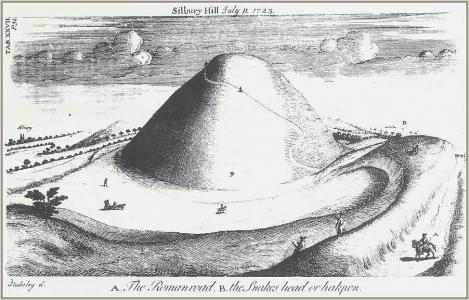
Avebury by William Stukeley. Dr. Holland, his annotator, writes thus of it. "Within one mile of Selbury, (by which he means Silbury-hill [Map]) is Abury, an uplandish village, built in an old camp, as it seemeth, but of no large compass. It is environed with a fair trench, and hath four gates, in two of which stand huge stones, as jambs; but so rude, that they seem rather natural than artificial: of which sort, there are some other, in the said village." In the time, when this was wrote, all the circles of these great stones, within the village of Abury, were nearly perfect; two of about 150 foot diameter, two of 300 foot diameter, and the great one of above 1000: which merited a higher notice. The largeness of the circles hindered an incurious spectator from discerning their purpose.
Avebury by William Stukeley. 18 Jul 1728. Table XI. Rundway hill 18 July, 1723. A. Bekhampton. B. the Model of a Camp. C. Celtic barrows. D. the way to Verlucio. [The drawing shows Silbury Hill [Map] and Cherhill aka Oldbury Hill Fort [Map]]
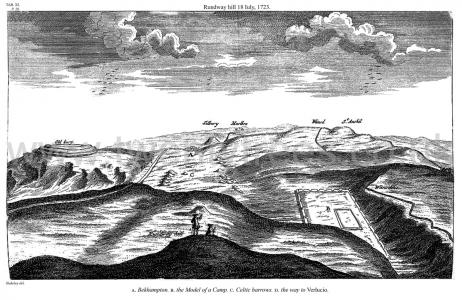
Around 1776 Edward Drax of Bath hired Cornish or Mendips miners on behalf of Hugh Percy 2nd Duke Northumberland (age 33) to sink a 40m shaft into the summit into Silbury Hill [Map]. His subsequent letters describing a 12m "perpendicular cavity" 15 cm wide were discovered in the British Library in Feb 2010. Fragments of wood, possibly found in a separate excavation, thought to be oak, were found at the bottom of the shaft. Drax wrote "We have already followed it already about 20 feet, we can plumb it about eleven feet more.".... "something now perished must have remained in this hole to keep it open".
On 23 Jan 2010 a lecture held at the Wiltshire Heritage Museum, Devizes, titled "Silbury Hill: the Archaeology of a Monumental Mound" by Jim Leary, the English Heritage archaeologist responsible for the survey on Silbury Hill in 2007/8 made no mention of a totem pole or oak tree found at the centre of the hill. There was also no mention of a separate excavation that found "fragments of oak".
Colt Hoare 1812. 1812. SILBERY HILL [Map] (Plate IV. No. 2.) is an artificial mound of such immense proportions, and so deceitful in its external appearance, that I could never have believed its having stood upon so much ground, had not ascertained the fact by an actual admeasurement.
The learned Stukeley has, in the description of this mound, given his reins to fancy, which has transported him beyond the regions of truth, or even probability for he has stated "that some king as the founder of the temple at Abury, and that Silbury hill was raised for his interment. His opinion, however, is always ingenious, and therefore lay it before my readers.
Silbury, indeed, is a most astonishing collection of earth, artificially raised, worthy of Abury: worthy of the King who was the royal founder of Abury, as may very plausibly affirm. By considering the picture of Abury temple, we may discern, that as This immense body of earth was raised for the sake of the interment of this great prince, whoever he was, so the temple of Abury was made for the sake of this tumulus; and then I have no scruple to affirm, 'tis the mast magnificent mausoleum in the world, without excepting the Egyptian pyramids."
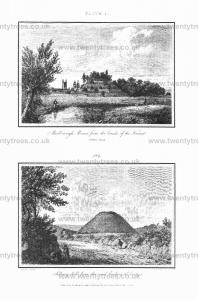
Druidical Temples in the County of Wilts Chapter IV. Chapter IV. Silbury Hill [Map].
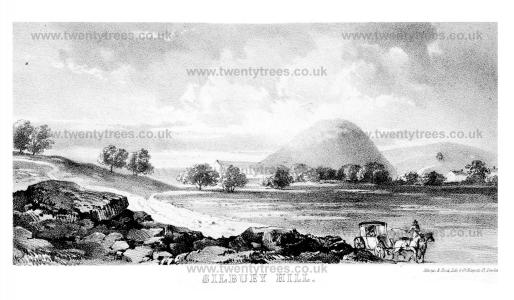
Silbury Hill by C Tucker. 1849. Report of the Examination of Silbury Hill [Map] by C Tucker 1849.
As soon as it became generally known in Wiltshire that the capital of that county had been selected for the seat of the annual meeting of the Archaeological Institute for the year 1849, the central Committee received from many quarters most urgent requests that they would turn their attention to the remarkable tumulus known as Silbury Hill [Map], and that a systematic examination of the hill should take place, by means of careful and scientific excavations into the centre of the vast mound, in order to discover, if possible, any objects or remains which could lead to the formation of just conclusions as to its origin, and a probably correct knowledge of the use or purpose for which it had been constructed.
Diary of a Dean by Merewether. Jul 1849. Diary Of The Examination Of Barrows And Other Earthworks In The Neighbourhood Of Silbury Hill [Map] And Avebury, Wilts, In July And August 1849 by John Merewether (age 52).
Diary of a Dean by Merewether. Jul 1849. Diary Of A Dean. Being An Account Of The Examination Of Silbury Hill [Map], And Of Various Barrows And Other Earthworks On The Downs Of North Wilts, Opened And Investigated In The Months Of July And August 1849. With Illustrations. By The Late John Merewether (age 52), D.D. F.S.A. Dean Of Hereford.
"Ducere Sollicitæ Jucunda Oblivia Vitæ." Hor. ["the pleasing oblivion of a life full of solicitude" Horace Satires Book 2 Saties VI]
London: George Bell, 186 Fleet Street. 1851.
Wiltshire Archaeological Magazine 1857 V4 Pages 307-363. Silbury Hill [Map]
I must proceed to say a few words respecting that remarkable conical and artificial mound, Silbury Hill, which stands due south of the great circle, and midway between the extremities of the avenues. Its name is supposed, by some, to be derived from the Anglo-Saxon words 'Sil' or 'Sel,' great, and 'bury,' mound:1 by others, Silbury is interpreted to mean the 'hill of the sun,' and to have had a similar dedication to that of the hills of Salisbury and Sulisbury at Sarum and Bath. This great work is supposed by Mr. Davies ('Celtic Researches') to have been the third of the mighty labours of the Island of Britain, viz., the piling up of the Mount of Assemblies. Upon this subject, Sir R. Hoare says, "In the Welsh Traids, perhaps some allusion may have been made to this stately mount, in the fourteenth Triad." 'The three mighty labours of the Island of Britain: erecting the Stone of Ketti; constructing the work of Emrys; and heaping the pile of Cyvrangon.' The Stone of Ketti is, upon good authority, supposed to be a great cromlech, in the district of Gower in Glamorganshire, still retaining the title of Maen-Cetti; and the work of Emrys or Ambrosius has been applied to Stonehenge. Why may not the heaping of the pile of Cyvrangon allude to Silbury? The three primary circles of Britain have been named Gorsedd Beisgawen, Gorsedd Bryn Gwyddon, and Gorsedd Moel Evwr; upon which Mr. William Owen, the celebrated Welsh scholar, has sent me the following explanation: "Cludair Cyvrangon and Gorsedd Bryn Gwyddon must have had their appellation, one from the other, as the names imply as much. For Cludair Cyvrangon means the heap of congregations or assemblies; not that the assemblies could have been held on Bryn Gwyddon or Silbury Hill, but that they were contiguous; that is, in the circle of Brynn Gwyddon, or the hill of the conspicuous or men of the presence; so that each of these places took their names respectively from each other; and it is thus that I identify Bryn Gwyddon and Cludair Cyvrangon in Silbury Hill and Abury."2
Note 1. Aubrey's account of Silbury is as follows. ''I returne now to the Mausolea of our owne countrey, and will first set down Silbury Hill in Wiltshire, a little on the right hand of the rode from Marleborough to Bristow, about a mile from Kynet, west. Iam sorry that I did not take the circumference of the bottom and top and length of the hill: but I neglected it, because that Sir Jonas Moor, Surveyor of the Ordnance, had measured it accurately, and also tooke the solid content, which he promised to give me; but upon his death, that amongst many excellent papers of his, was lost. I remember, he told me, that according to the rate of work for labourers in the Tower at.... the floor, it would cost threescore or rather (I think) fourscore thousand pounds to make such a hill now.
"No history gives any account of this hill; the tradition only is, that King Sil or Zel, as the countrey folke pronounce, was buried here on horseback, and that the hill was raysed while a posset of milke was seething. The name of this hill, as also of Silchester, makes me suspect it to be a Roman name, se, Silius."—Mon. Brit., vol. ii. pt. 3, page 6.
Note 2. Ancient Wiltshire, vol. ii,, p. 83.
Wiltshire Archaeological Magazine 1860 V7 Pages 145-191. Silbury [Map]. By the Rev. A. C. Smith, M.A. Read before the Society at Avebury during the annual Meeting at Marlborough, September, 1859-
"Unchanged it stands: it awes the lands
Beneath the clear dark sky ;
But at what time its head sublime
It heavenward reared, and why —
The gods that see all things that be
Can better tell than I."1
Note 1. Bode's Ballads from Herodotus, p. 102.
Wiltshire Archaeological Magazine 1868 V11 Pages 113-118. A Report of Diggings made in Silbury Hill [Map], and in the Ground Adjoining. By the Rev. Prebendary Wilkinson.
Wiltshire Archaeological Magazine 1886 V23 Pages 245-253. 1887. Recent Explorations at Silbury Hill [Map] By Alfred C. Pass.
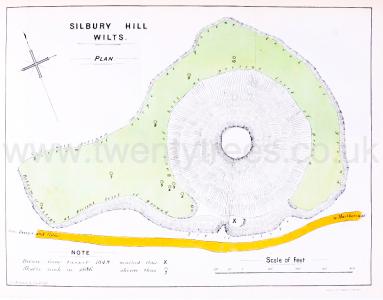
Report Of Diggings In Silbury Hill by Flinders Petrie. Aug 1922. Report Of Diggings In Silbury Hill [Map] by Prof. W. M. Flinders Petrie (age 69), F.R.S. From the 14th to the 30th of August, 1922, I made some examination of Silbury Hill, with the kind co-operation of Mr. A. D. Passmore.
From 1968 to 1970 Richard J C Atkinson (age 49) undertook excavations at Silbury Hill [Map] that were filmed by the BBC. He dug numerous trenches at the site and reopened the 1849 tunnel, where he found material suggesting a Neolithic date. His carbon dates are considered unrealiable.
Silbury Hill [Map] is visible from some, but not all, of the Avebury Henge - the red line on the Schematic.
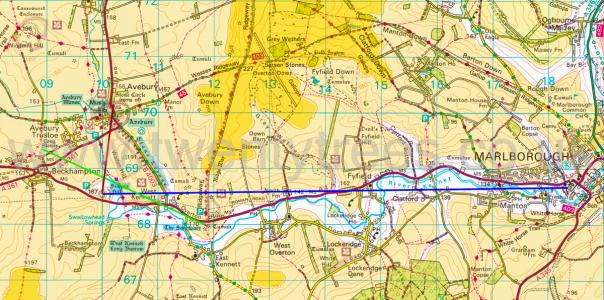 The light orange is land above 150m. The dark orange is land above 200m.
The light orange is land above 150m. The dark orange is land above 200m.
It appears that the Marlborough Mound [Map] is visible from Silbury Hill [Map] - the blue line on the Schematic. If it is it suggests the Marlborough Mound and Silbury Hill were constructed for the same purpose?
 The light orange is land above 150m. The dark orange is land above 200m.
The light orange is land above 150m. The dark orange is land above 200m.